Global Private Equity Report

Executive Summary
- ESG investing continues to face skepticism in the private equity industry, especially in the US.
- But proactive firms aren’t waiting for ROI studies to pan out before incorporating sustainability and social responsibility into how they invest and operate.
- ESG isn’t just a nice thing to do. It is becoming a critical element in gaining market share, engaging employees and raising capital.
This article is part of Bain's 2021 Global Private Equity Report.
Until there is consistent data establishing a positive link between ESG investing and financial returns, there will always be skepticism among private equity investors. That’s just the way the industry is wired.
We’ve all seen the anecdotal evidence that companies can actually “do well by doing good” when they adhere to environmental, social and corporate governance (ESG) standards. But no matter the ownership model, there is reluctance to dive in headfirst, and PE firms face a unique mandate to produce substantial returns quickly.
ESG is broad and amorphous, notoriously hard to define. We lack time-tested standards for measuring either results or impact. That, not surprisingly, leads to muted enthusiasm among some firms and check-the-box efforts among others. Very often, it seems, firms skew toward the “E,” putting new labels on cost or efficiency initiatives that they would have implemented anyway. As Institutional Investor put it in a June 2020 headline, “Private Equity Makes ESG Promises. But Their Impact Is Often Superficial.”
This clearly isn’t always the case. TPG, for instance, has enthusiastically adopted ESG principles both internally and within its portfolios. It is also a leader in launching impact funds and made a high-profile announcement in January that former US Treasury Secretary Hank Paulson would join the firm as executive chairman of TPG Rise Climate, a new fund focused on climate-related investments. At the same time, signatories to the United Nations’ Principles for Responsible Investment (PRI) jumped 28% last year and now number more than 3,000 institutional investors and PE firms, representing a staggering $103 trillion of assets under management.
Yet a closer look at the numbers suggests that real commitment to ESG is less monolithic. While the PRI signatory list includes 431 PE firms from around the world, only 16 of them disclose ESG’s impact on financial returns, according to Institutional Investor, and only half use ESG principles in monitoring more than 90% of their portfolio companies.
There’s also a wide gap in adoption between the PE industry in North America and that in Europe. While 80% of the top 20 EU-based institutional investors have committed to either the PRI, the UN’s Net-Zero Asset Owner Alliance or the Task Force on Climate-related Financial Disclosures, less than half of the top 20 North American institutions have done so, and many of those are based in Canada (see Figure 1).
Limited partners in Europe lead the world in committing to global standards for responsible and sustainable investment
An analysis of ESG performance among PE firms by EcoVadis, a leading global supplier of business sustainability ratings, shows that portfolio companies owned by US-based firms trail those owned by EU-based firms by 12 points. Yet even in Europe there is ample room to grow. Looking at sustainability factors only, the great majority of EU-owned portfolio companies haven’t launched meaningful initiatives (see Figure 2). And the broader corporate world isn’t much further along. EcoVadis data shows that PE-owned companies and corporations are pretty much neck and neck when it comes to ESG maturity scores in both the US and Europe.
European LPs have embraced ESG much more eagerly than those in North America, but there’s still room to grow
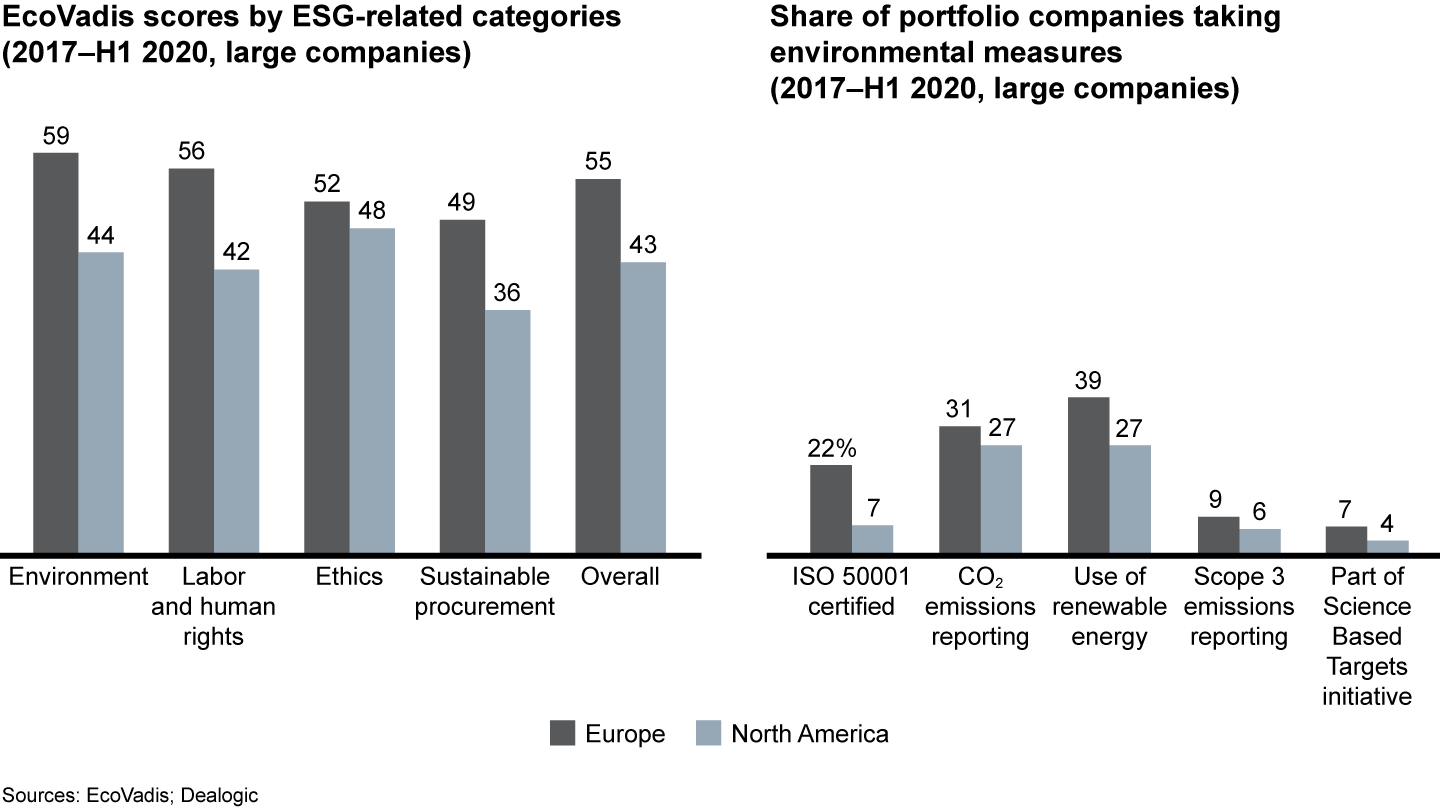
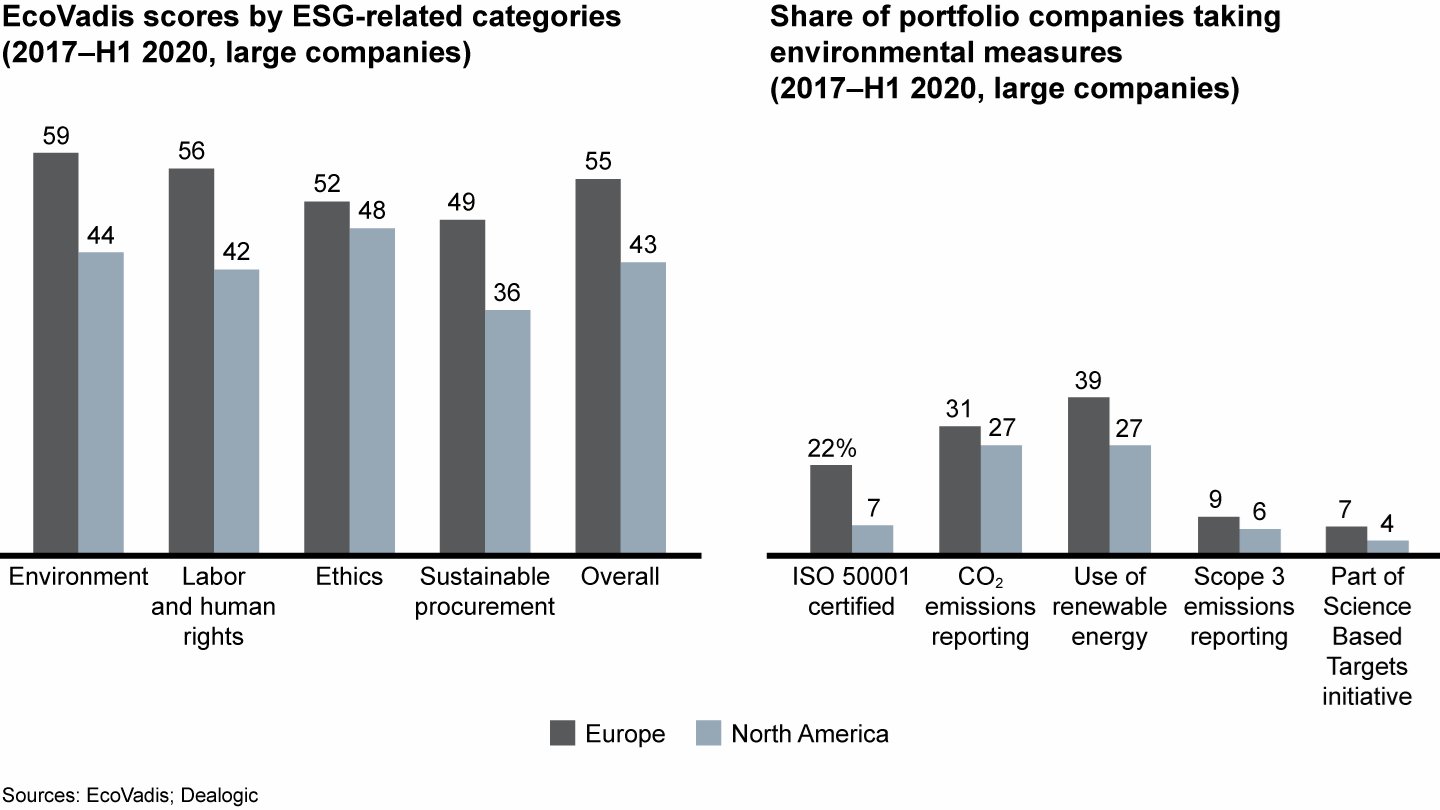
A building wave of change
So is ESG one of those particularly persistent investment fads that will eventually fade away? We wouldn’t bet on that any more than we’d bet against the historic groundswell of global concern around climate change, social upheaval and corporate responsibility. What’s made the PE industry successful in the past is its ability to anticipate future currents of value creation and to think more broadly about how they will reveal themselves. We believe this is one of those moments.
Sensing that broader economic forces are rapidly changing behaviors and attitudes, many firms aren’t waiting for ROI studies to prove out before banking on ESG. A growing segment of the industry believes that investments in sustainability, social welfare and good governance require a different calculus for now—at least if they want to get ahead of the game.
In the few short years since ESG appeared on the scene, the industry has tended to view it as a sideshow—something good to do in addition to a fund’s normal business of buying and shepherding companies. Some firms have actually segregated these efforts into discrete funds wholly devoted to impact investing, where the goal is to generate social or environmental impact at market-rate returns (see Figure 3).
Leading firms see ESG investing as a core part of creating value and mitigating risk
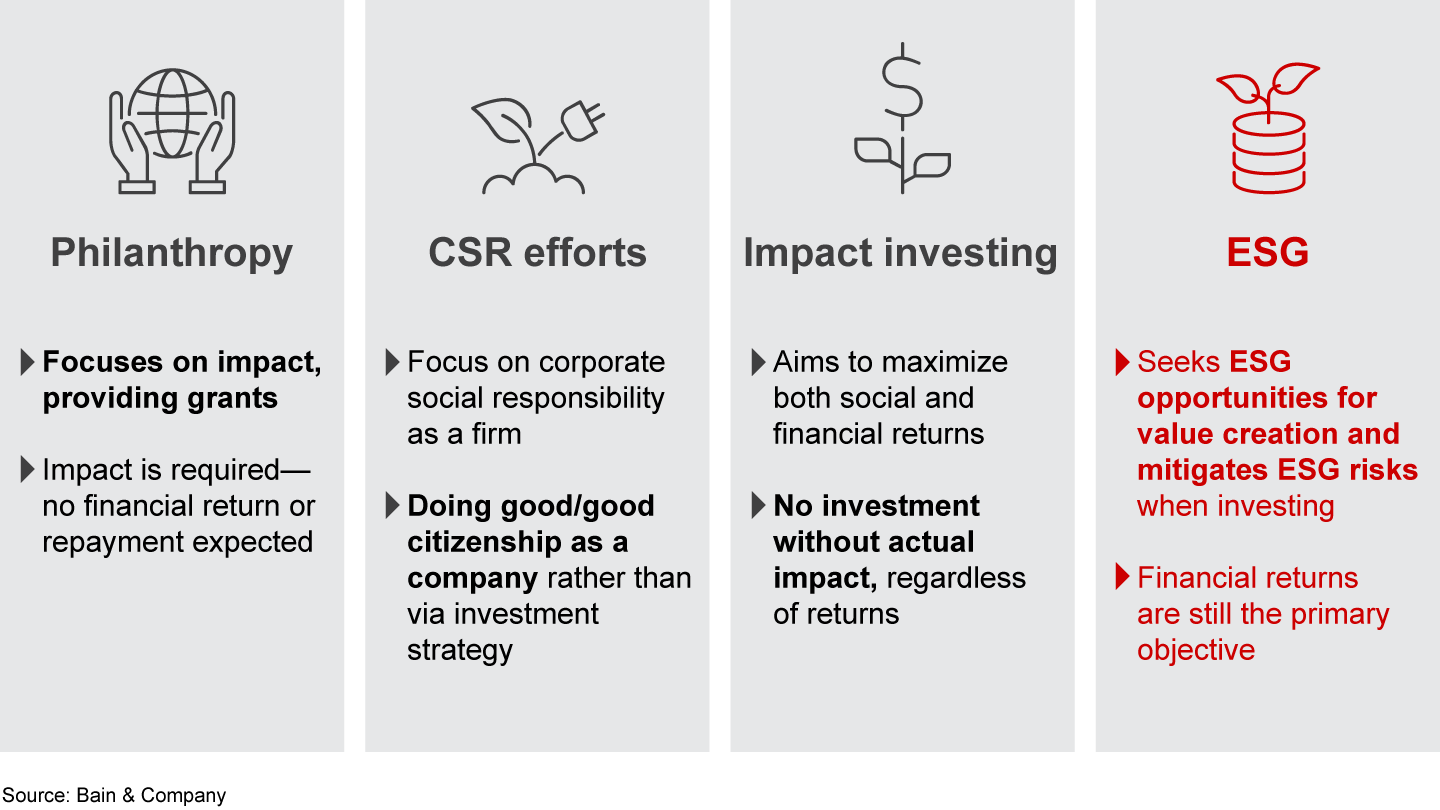
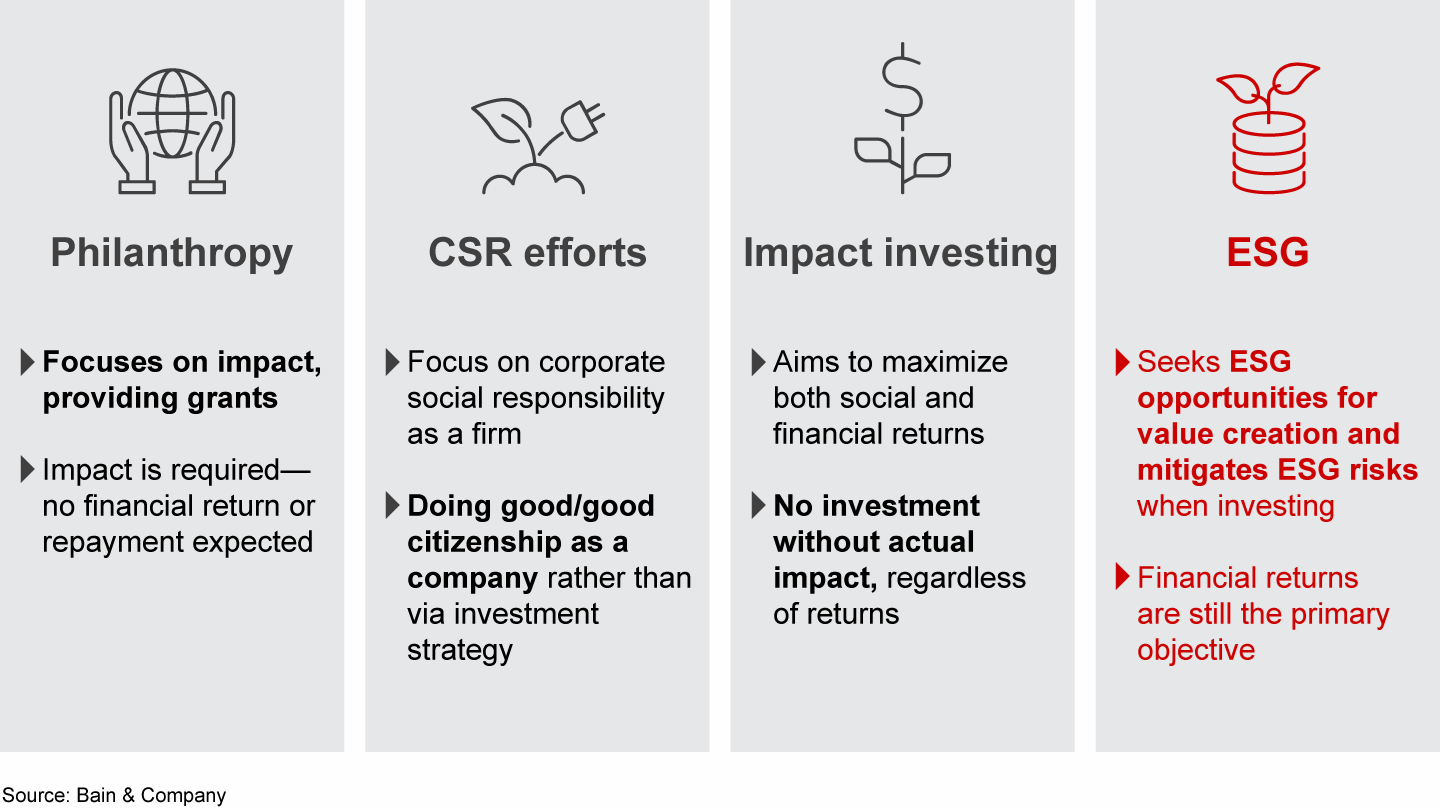
As ESG matures, however, the firms leading the charge—mostly in Europe—talk less about discrete, segregated ESG initiatives and more about delighting customers, gaining market share, engaging employees and creating the best work environment. As with sector expertise or technology acumen, they have come to consider ESG a core part of what differentiates them as competitors, baking ESG principles into sharpening due diligence, building stronger value-creation plans and preparing the most compelling exit stories.
Private equity has always focused on governance risk and increasingly sees the value in cutting costs through sustainability. What’s changing is firms’ growing awareness that environmental, social and governance issues are highly interrelated and that the biggest benefits over time accrue to companies that balance efforts between all three.
The desire to contribute to a better world is certainly a motivator, but the rationale is all business. These firms recognize that consumers, regulators, employees and sources of capital are energized by the notion that investors can and should use their economic clout to address the many existential crises we face as a society. Each of these groups is ramping up demands for change and, in many cases, rewarding it (see Figure 4).
Stakeholders of all kinds want companies to be more sustainable, socially conscious and well governed
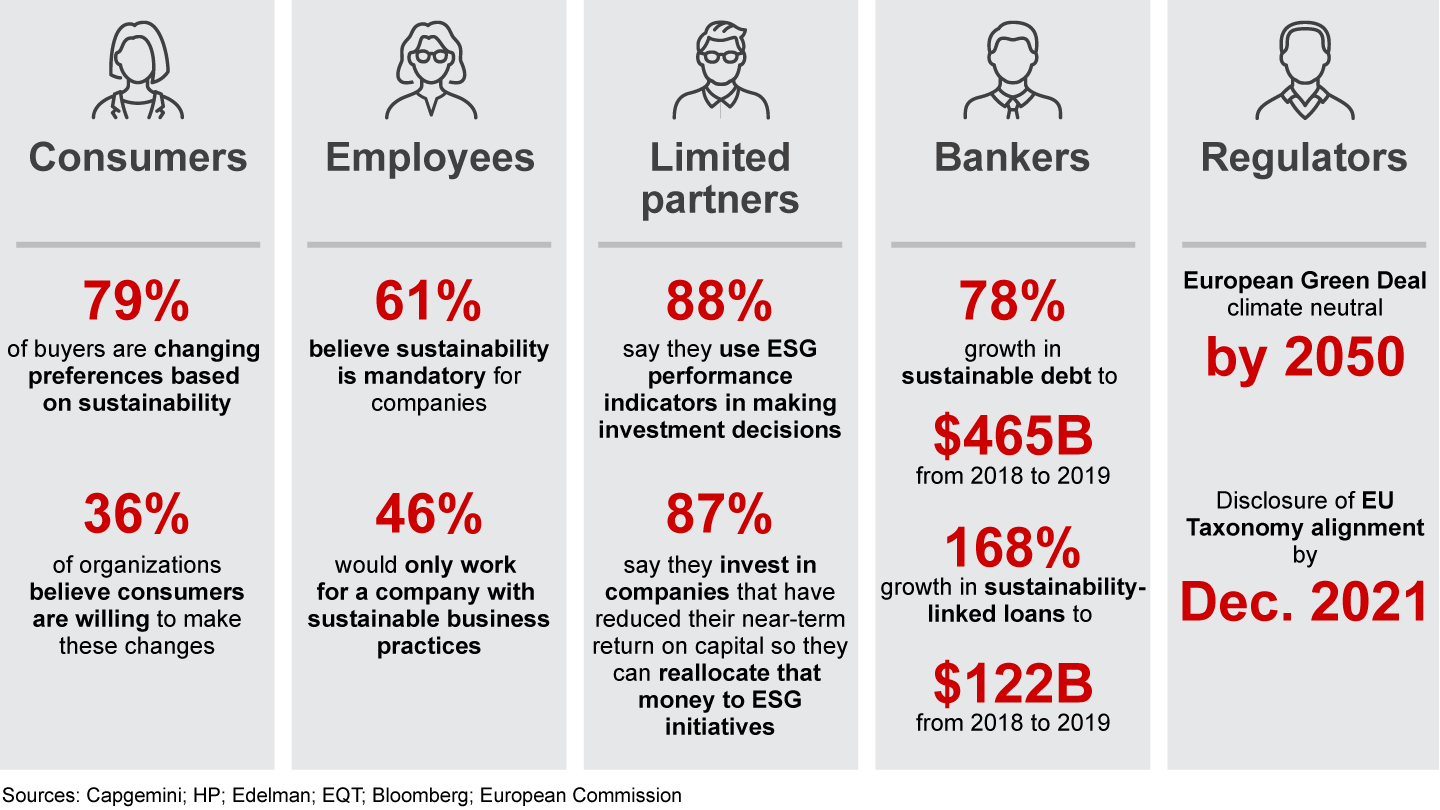
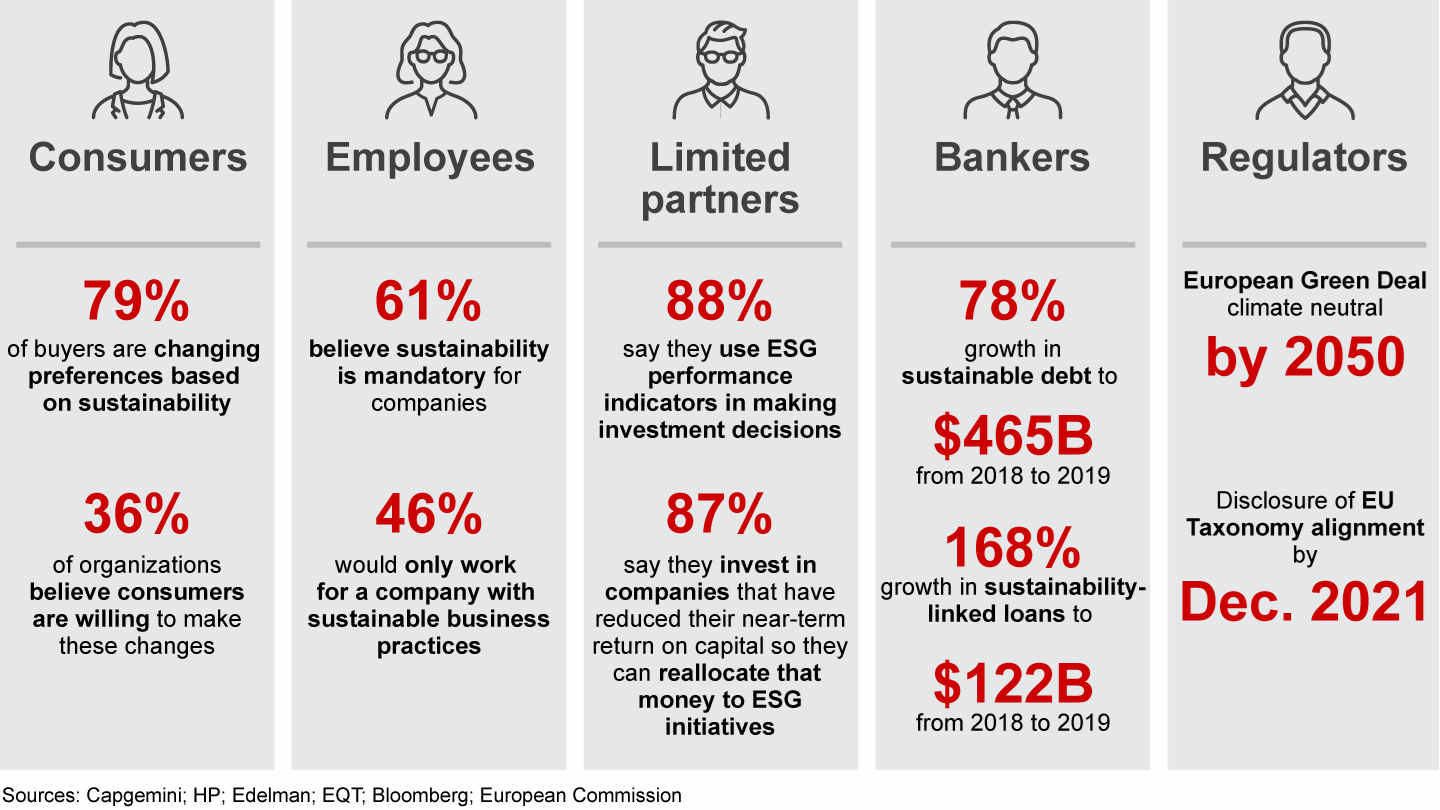
Consumers. Survey after survey shows that consumers—especially the surging wave of millennials and post-millennials—are flocking to companies that they believe act responsibly. “Doing the right thing” may be an imprecise concept, but consumers clearly know it when they see it. Increasingly, it is becoming a critical element of customer loyalty, as measured by Net Promoter Scores.
A 2020 Capgemini survey of 7,500 consumers and 750 executives globally found that 79% of buyers were changing their preferences based on sustainability. At the same time, only 36% of organizations believed consumers were willing to make these changes. This disconnect is surprising given that companies clearly see a payoff when they buy into the shift in behaviors. A full 77% said sustainability initiatives increased customer loyalty, and 63% have seen a revenue uptick.
What’s clear from the data is that capturing the favor of these ESG-minded consumers has enormous upside. Nielsen estimates that, in the US alone, buyers will spend up to $150 billion on consumer packaged goods viewed as sustainable by 2021.
CVC is one of the firms that speaks less about ESG in isolation and more about using it to create value. As managing partner Jean-Rémy Roussel said in a recent episode of Bain’s Dry Powder podcast, “It’s not a trade-off, it’s not a risk management/litigation issue, it is not conformance to regulation. It is a unique opportunity.”
CVC has developed a systematic approach to embedding ESG and corporate social responsibility initiatives into its value-creation plans, with the specific goal of improving market share and increasing deal multiples. The approach is rooted in the belief that private equity’s traditional focus on boosting EBITDA is actually less effective than focusing on customer loyalty and employee satisfaction, which ultimately generate more value and therefore higher multiples. When CVC buys a company, one of the first things it does is collect hard data on customer and employee satisfaction. It then helps management figure out how to target six key areas—customer focus, simplification, human capital, communities, environment and governance—to improve performance.
A good example of how this works is CVC’s 2017 acquisition of Żabka, a Polish chain of franchised convenience stores. In diligence, CVC identified a number of ESG-related efficiencies and savings. It replaced refrigerants in 2,200 stores and took other measures to reduce annual carbon dioxide production. It reduced the weight of the packaging for one of the chain’s sandwich brands, eliminating three tons of plastic waste. At the end of 2020, it launched a more comprehensive program to reduce CO2 by at least 5% per year and reach net zero by 2050. It is currently investigating the most credible way to offset CO2 production at the company level.
The big upside was reengaging with customers to grab market share in a largely stagnant industry. As Żabka studied how to optimize the assortment in its stores, it saw that consumer tastes had shifted dramatically away from typical convenience store fare. The company worked with suppliers to source healthier and more responsible ingredients for its products. It became the first retailer in Poland to use 100% recycled plastic bottles in its branded beverages. It started taking the market lead in selling plant-based food products, hailing their “triple benefits”: customer health, environmental friendliness and animal welfare.
Corporate social responsibility also became increasingly core to the company’s ethos. Żabka now trains employees and franchisees to sell alcohol more responsibly and to recycle more effectively. It has set up programs to eliminate food waste by transferring surpluses to food banks. The company runs career development programs for employees, and it funds scholarships and internships for children from disadvantaged backgrounds.
The results have been impressive: Loyalty and satisfaction scores have soared among customers, employees and franchisees. That led to 20% annual revenue growth from 2017 to 2020, while gross margins increased by 3.9 percentage points. The chain added 652 new stores in 2019, and employment has risen sharply. Social responsibility initiatives have raised the company’s profile across Poland, and a broad corporate campaign to communicate these values and successes has embedded a new sense of purpose throughout the organization.
Employees. As Żabka has discovered, a commitment to sustainability and social responsibility is rapidly becoming essential to attracting and retaining key talent. Research shows that employee loyalty increasingly hinges on a belief that they are working for a company with a nobler mission than just churning out quarterly earnings. A global HP survey of 20,000 workers in 2019 found that 61% believe sustainability is mandatory for companies (on par with diversity and inclusion), and nearly 50% said they would only work for a company with sustainable business practices.
At Unilever, which has made a major public commitment to sustainability, about half of all new employees entering from college say the company’s ethical and sustainability policies are the main reason they wanted to hire on. A sense of mission leads to greater satisfaction, which in turn leads to higher productivity.
Limited partners. One reason ESG is top of mind for PE firms around the world is that a growing number of LPs are demanding it. According to the 2020 Edelman Trust Barometer Special Report: Institutional Investors, 88% of LPs globally use ESG performance indicators in making investment decisions, and 87% said they invest in companies that have reduced their near-term return on capital so they can reallocate that money to ESG initiatives. As noted above, European LPs have demonstrated more commitment to ESG than their counterparts in North America, but the biggest institutions in the US and Canada, including the CPP Investment Board, CDPQ, CalPERS and the California State Teachers’ Retirement System, are firmly on board.
For general partners, this means that ESG is fast becoming a central factor in raising money. CVC’s Roussel, for instance, said that one-fifth of the LPs invested in the firm’s recently closed Fund VIII required an audit showing evidence that ESG was part of the firm’s decision making during both due diligence and ownership. CVC has commissioned EcoVadis to undertake annual assessments of its portfolio companies to demonstrate how ESG maturity has improved under its ownership.
Bankers. Despite the lack of evidence linking ESG to returns, a growing slice of the financial world assumes that sustainable, socially responsible companies are less risky. As a result, PE firms are finding ways to monetize their ESG strategies by lowering their cost of capital. EQT, for instance, launched two ESG-linked subscription credit facilities in 2020 worth €5 billion, with interest rates that decline if the firm performs well against a set of ESG indicators. Firms like Investindustrial and KKR have developed other financing vehicles with ESG incentives or targeted uses. In late 2019, Jeanologia, a Carlyle-owned company that creates clean technologies for jeans manufacturing, agreed to a loan with a rate tied to water savings.
Per Franzén, cohead of the EQT Private Equity Advisory Team, calls the shift to credit-linked facilities “a game-changing moment” for the private equity industry: “By linking sustainability objectives to hard incentives, we are really challenging ourselves and the portfolio companies to fully embrace the potential of sustainability.”
Regulators. If ESG-linked credit facilities are the carrot, regulation is the stick. One reason European firms are addressing ESG more urgently than their US counterparts is that EU regulators are on the case. The EU Taxonomy, a landmark initiative aimed at channeling private capital into sustainable assets, will take effect in December 2021. It will force asset managers in the EU to disclose their share of taxonomy-aligned assets under management, inevitably creating an incentive to raise that share to remain competitive.
By contrast, US regulators are headed the other direction—at least for now. The US Department of Labor in November 2020 issued a rule discouraging fiduciaries from using nonfinancial (read: ESG) principles in screening pension investments.
Taking the lead
This push and pull between skeptics and believers is typical of game-changing moments. The market, of course, will eventually decide the case, but momentum is building in powerful places. While the top 20 LPs in the US on average may be less inclined or incented to join their global counterparts in committing to ESG, fund-raising is a global business, and GPs still face firm pressure from investors to show progress on these issues. Meanwhile, the firms in the lead are building ESG investing into a differentiating capability. They are convinced it will give them an edge in a PE market that has never been more competitive.
What does it look like to build ESG into the value-creation cycle from beginning to end? Consider EQT’s approach in 2016 when it bought AutoStore, a Norwegian maker of warehousing robots that is headquartered on a remote fjord, a six-hour drive from Oslo. The warehouse industry had limited focus on environmental or workplace issues at the time. But the firm and management saw an opportunity to change the conversation with AutoStore’s flagship robot, which automates retail warehouses by wandering through a compact shelving system, picking and packing.
EQT anticipated two ways it could create value at AutoStore. First, the firm would encourage the company to address its own footprint with a series of cost-saving initiatives aimed at decreasing consumption and reducing carbon emissions. Second, it would focus the company’s marketing on sustainability and workplace quality. AutoStore’s robot already used less energy and was significantly quieter than any other product on the market. But the management team and salesforce weren’t hitting those value arguments in their sales pitch.
EQT’s perspective came from the top of the firm―one of its primary investment themes is that sustainability attributes are increasingly becoming key purchasing criteria in any industry, and the AutoStore deal team was convinced warehousing was no different. To bring the company’s leadership on board, it launched a set of value-creation initiatives linked to sustainability and put a regular reporting function on the board agenda, tying environmental concerns to governance. The company also launched a project to determine if the robot’s sustainability features were a point of differentiation among customers. The answer was yes.
Leadership directed the company’s R&D lab to make its robot even more sustainable and worker friendly. By switching from a lead-acid to lithium-ion battery and increasing the share of recyclable components, engineers significantly reduced the carbon footprint of the product while maintaining its remarkable energy efficiency. (The robot uses one-tenth the energy of a vacuum cleaner.) By running in the dark, it also reduces energy usage within the warehouse.
Armed with a much improved next-generation product, the company then retooled its communication strategy to focus on sustainability and savings alongside the robot’s impressive technical abilities. The new message resonated loudly with customers globally. During EQT’s ownership, its global installations grew by 2.5 times, the number of installed robots tripled, revenues quadrupled and EBITDA increased by 4.5 times. And the social impact was significant: During ownership, global employment doubled, including in the small village where the company has its headquarters and is an important contributor to the local economy.
ESG isn’t about doing good for good’s sake; it’s about recognizing what customers really want and turning that into a strategy that creates tangible value.
EQT’s insight was that, even in a hard-bitten B2B industry like warehousing, sustainability matters. ESG isn’t about doing good for good’s sake; it’s about recognizing what customers and other stakeholders really want and turning that into a strategy that creates tangible value. Funds are finding that ESG issues that weren’t necessarily a factor commercially a few years ago are now front and center. And Covid-19 has only accelerated the pace of change. A Bain survey of more than 12,000 consumers in the US and EU showed that 44% agree or strongly agree that sustainability will be even more important in the wake of the pandemic (see Figure 5).
In the wake of the Covid-19 pandemic, consumers are embracing sustainability more than ever
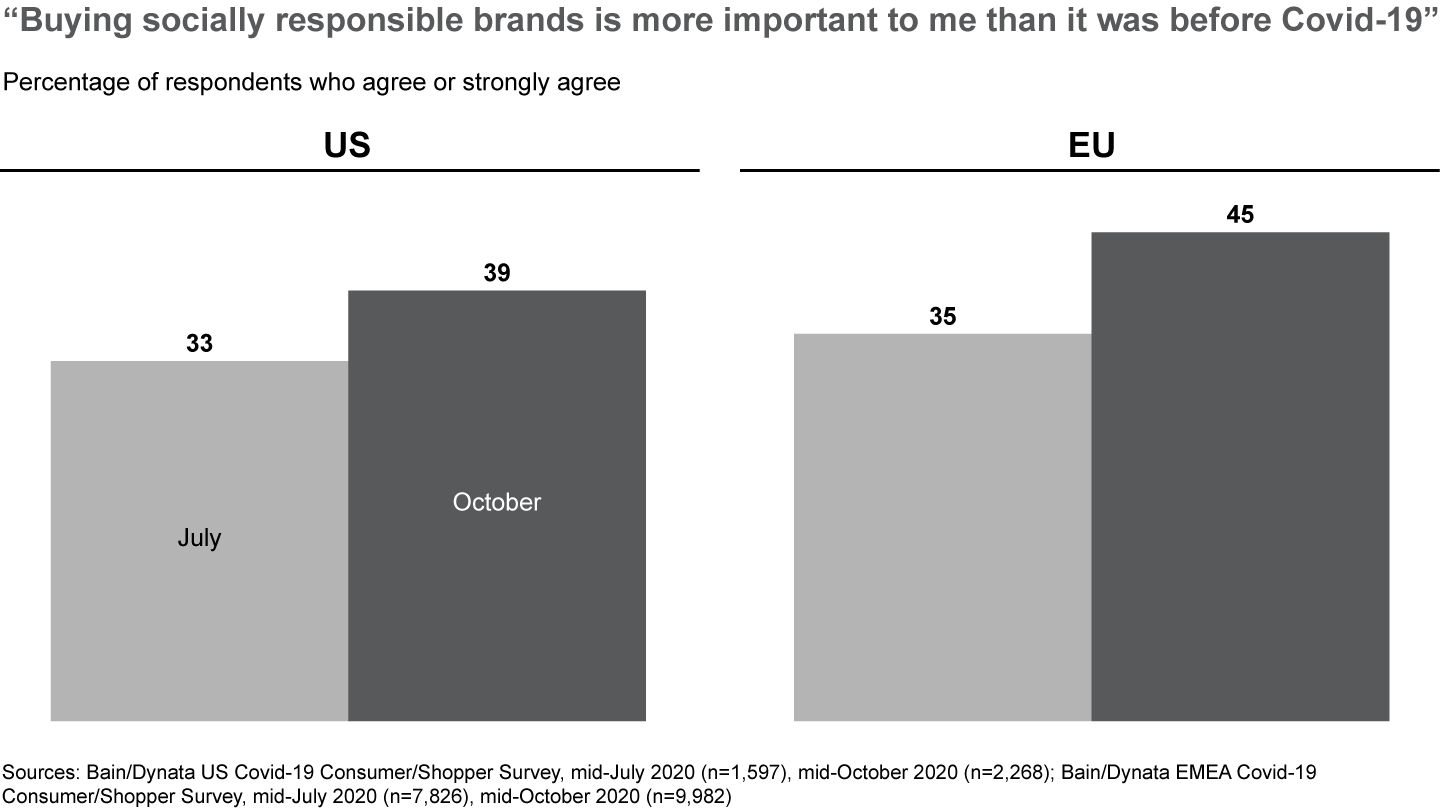
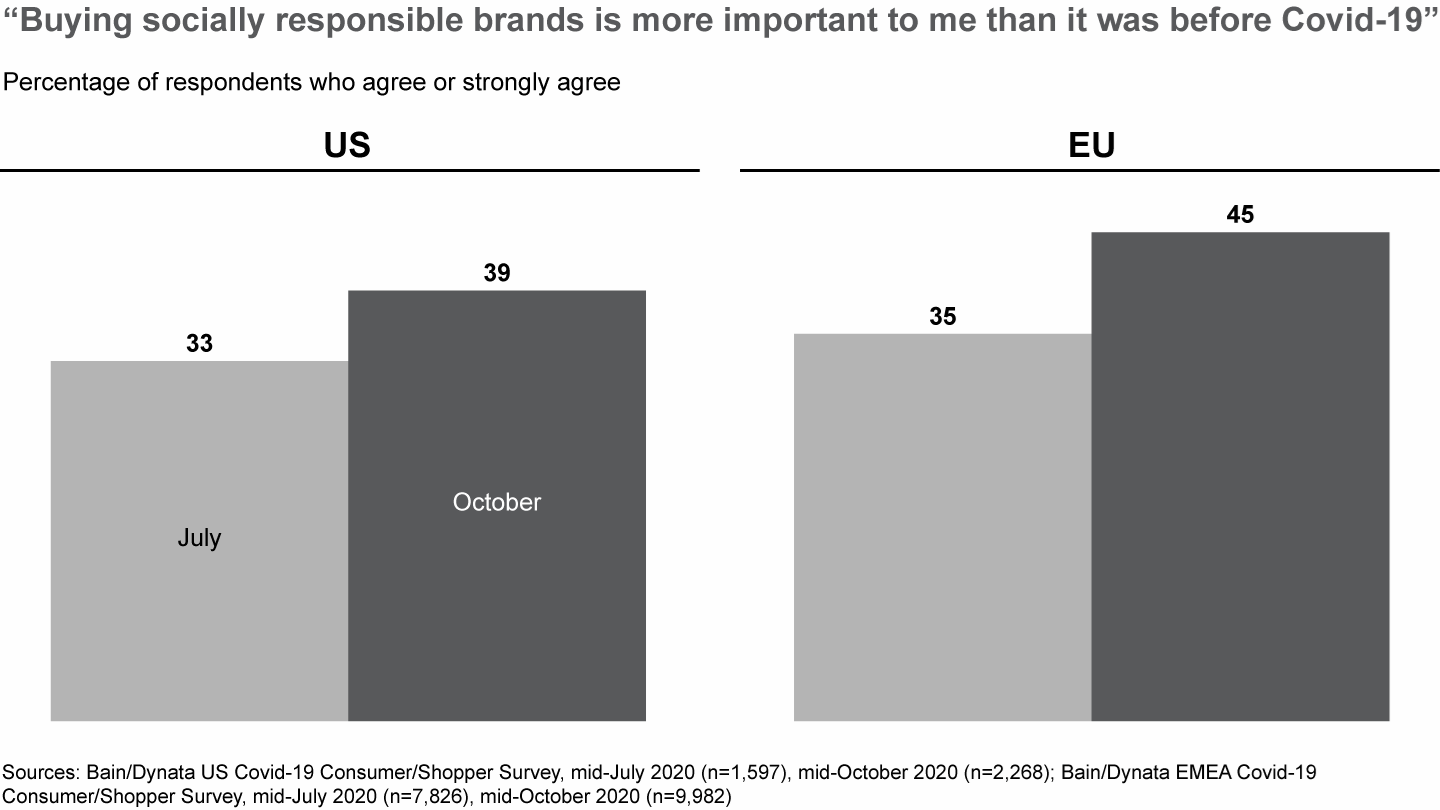
The message is gradually sinking in across the PE industry. During a recent refresh of its value-creation plan for a paper company, a PE firm identified a potential 3- to 5-point EBITDA uplift tied to a series of sustainability initiatives, including revamping its product lineup in a sustainable way. Responding to consumer demands for products easier on the environment, the company plans to rapidly expand its 100% recycled products and those made from alternative fibers like cotton. That will give it time to tap a set of lucrative new markets by developing paper-based alternatives to plastics in products like transparent-window envelopes and composite packaging.
Sustainability is becoming a central theme in its marketing and changing the company’s positioning globally. The plan anticipates that revenue growth—and avoided revenue loss—will be the biggest contributors to improved results (see Figure 6).
One PE owner plans to use ESG initiatives to boost cash flow at a recently acquired paper company
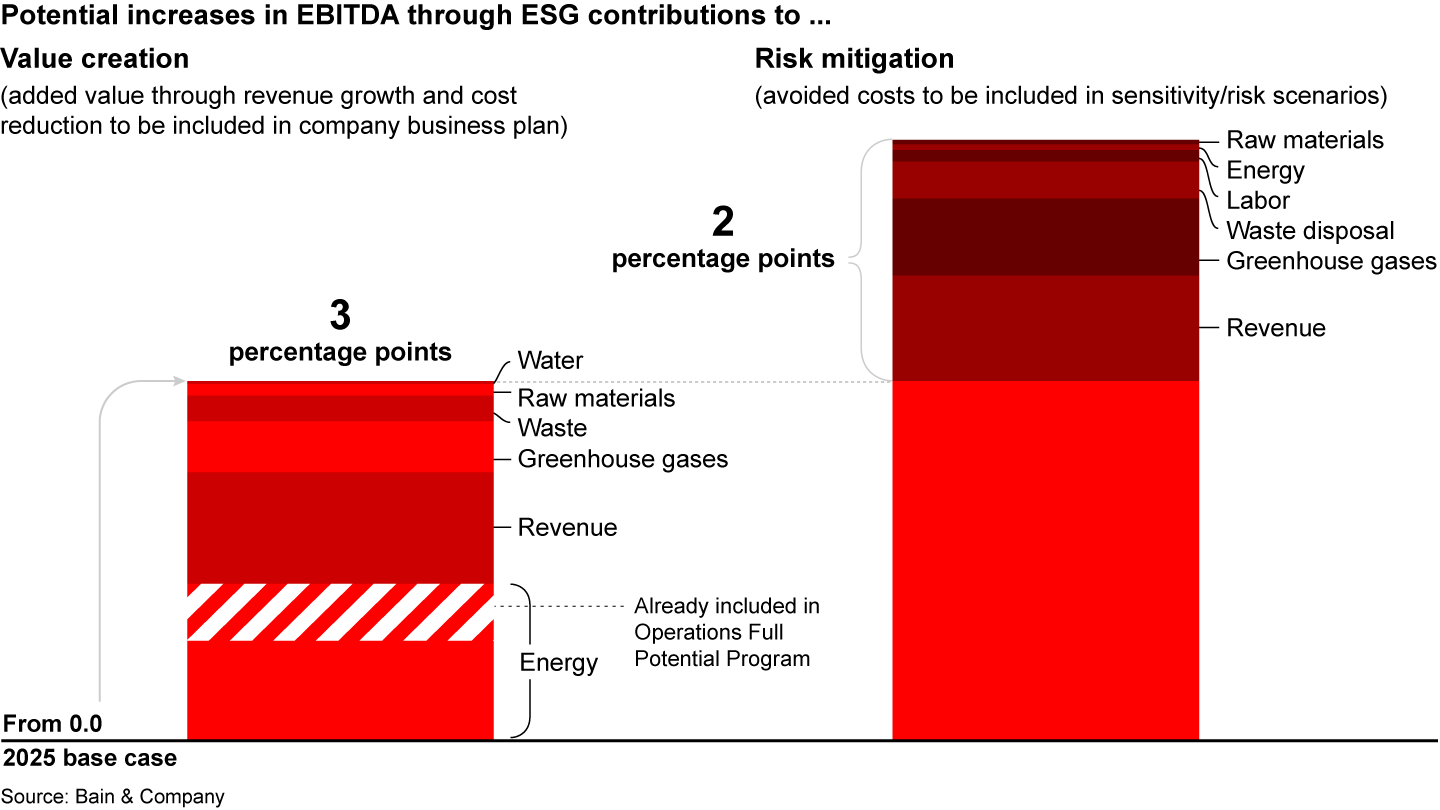
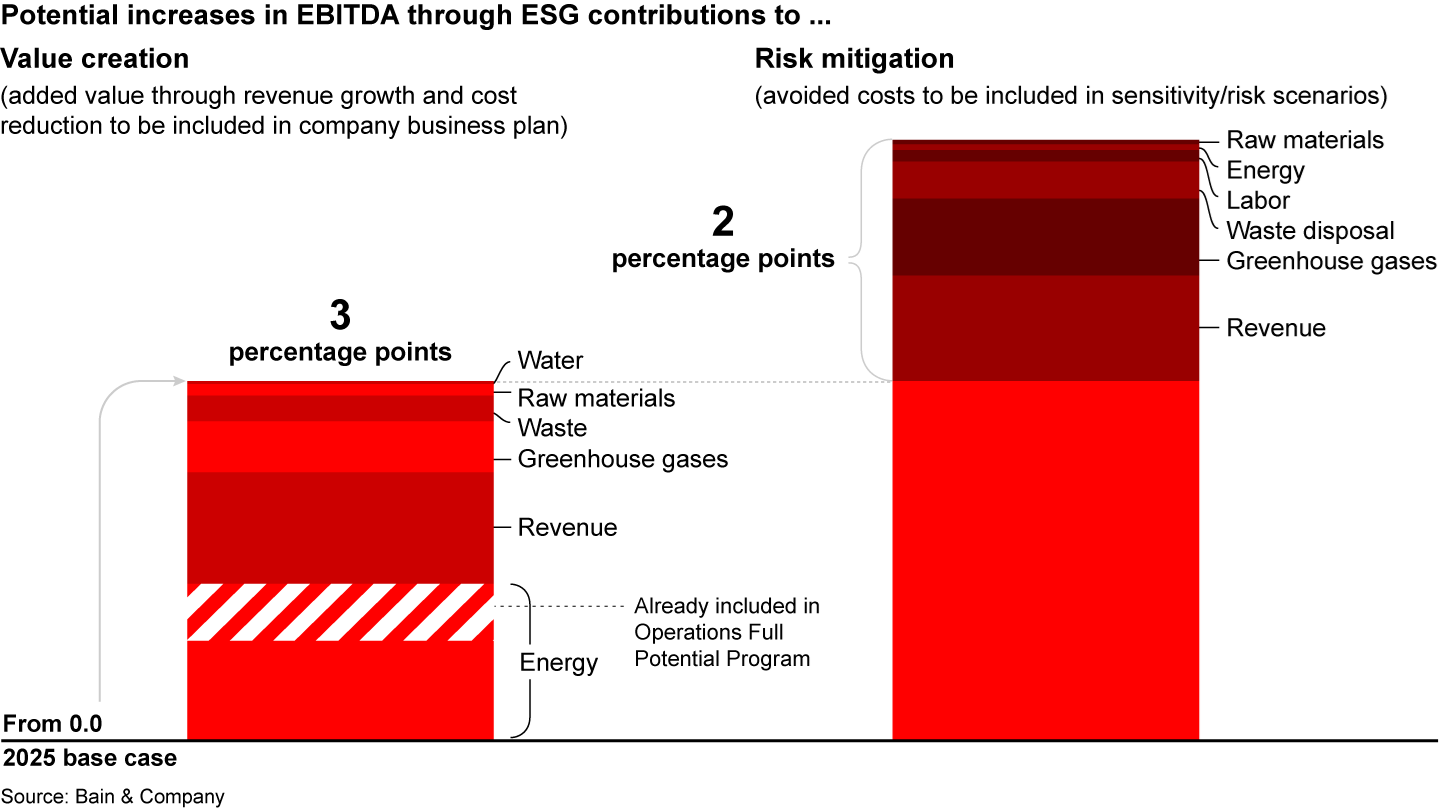
The opportunity even exists in industries you wouldn’t expect. ESG value creation seems obvious in “clean” or socially conscious sectors—electric vehicles, alternative energy, education, healthcare and so on. But GPs are recognizing that the next buyer will often pay a higher multiple for a company in an environmentally questionable industry that has become more sustainable and responsible than its competitors.
Investindustrial has developed a potent franchise in sustainable investing partly by finding—and fixing—companies like Polynt-Reichhold, a specialty chemicals player with some 40 manufacturing facilities globally. Through various sustainability measures, the company reduced its carbon intensity to a level approximately 40% below its best-performing peers. A global shift to LED lighting shaved 400 megawatt-hours of electricity usage per year. Improving insulation on its storage tanks in Norway saved 800 megawatt-hours annually.
The quest for a winning ESG formula
While ESG investing has crawled out of its infancy, it remains early days. Even the leading firms are still figuring out where to play and how to win. One thing is already clear, though—making it work takes the same level of commitment and ambition firms devote to developing any new differentiated capability.
In our experience, the firms getting it right have a few things in common:
- Clear definition, alignment and ambition. ESG can mean a lot of things, so it is critical that firms define what it means for them and build on that. Winning firms also go well beyond lip service by securing alignment around their chosen ambition, starting with the investment committee and extending to individual portfolio and deal teams. Setting up a central ESG team and hoping for the best is not a recipe for success.
- Focused execution. Different companies in different industries need to apply ESG differently. What’s important is to pick a few things that really matter and move the needle in those areas. Increasing diversity or reducing the carbon footprint are good places to start, but it takes real commitment and execution to produce results. It’s also important to build on early wins to communicate success and expand the scope.
- Full integration. Capturing the true value of ESG requires embedding it along the entire PE value chain, from due diligence through ownership to exit. While it might not be an investable theme in all deals, it certainly should be a consideration in every diligence. The most effective firms treat it as a capability. They strive to make ESG second nature—an integral part of value creation. Simply tracking random KPIs isn’t enough. Firms need to have a value-creation strategy specific to their industry and customer base.
- Capability investment. Most firms that have adopted ESG have started with risk mitigation and compliance issues. Taking the next step to value creation requires adding capabilities to identify, track and manage ESG risks and opportunities effectively. Firms also need to learn how to take advantage of sector-level ESG experts, partners and other ecosystem resources to support value-creation plans.
- Measurement of results and continuous improvement. As with anything else, getting better at ESG investing relies on continuous learning and not waiting for the perfect answer. Firms that have built a track record of ESG value creation have been willing to experiment and then develop winning approaches into playbooks and repeatable models that lead to consistent results. That means establishing clear measures of year-over-year continuous improvement and setting up processes to roll up and monitor ESG performance across the portfolio.
Skepticism around ESG will persist as long as we lack empirical evidence that it pays off. Devising the right measures will take time and creativity. That said, ESG is rapidly moving to the center of how many firms view the value-creation process as they pick up and follow what the market is telling them.